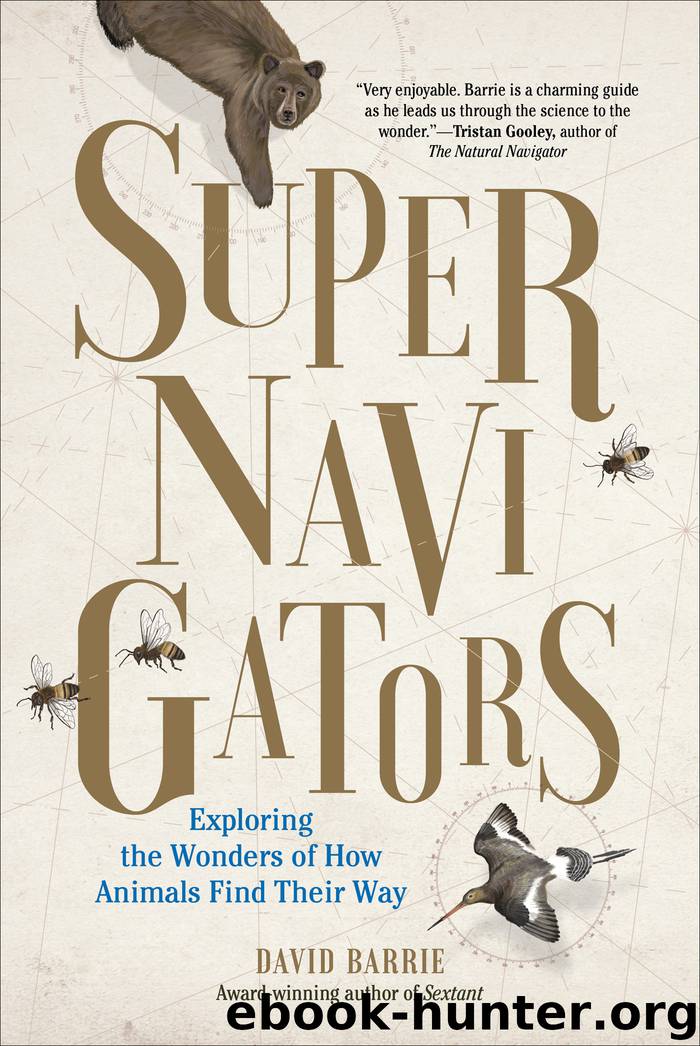Supernavigators: Exploring the Wonders of How Animals Find Their Way by David Barrie

Author:David Barrie
Language: eng
Format: epub
Publisher: The Experiment
Published: 2019-05-27T23:00:00+00:00
Where the bogong sleeps
When I arrived, the team had already been at work for some time and were running short of moths, so we needed to catch some more. Since we could not set up the light trap until it was dark, we decided to pay a visit during the day to the rocky crevices on the mountaintops where the moths gather in such vast numbers.
Eric and I, together with Anja Günther and David Szakal, made an early start for Thredbo, a ski resort in the steep valley of the Crackenback River. Since it was late summer, the town was very quiet, but we were able to take a ski lift up to an altitude of about 2,000 meters, and we then climbed through thick undergrowth and sphagnum bogs to reach the bleakly beautiful mountain tops. The moorland was dotted with flowers, and we soon found ourselves completely alone—apart from a few wild ponies and the ravens circling in the sky above us.
The Snowy Mountains are exceedingly old, and they look it. On every rounded summit, the tors rise in colossal, rounded sculptural shapes. Not many people know how to find the caves where the moths roost, but Eric led us to one of the best sites. There were few visible tracks to follow and at several points—ironically enough—we had to stop to check where we were. After a long hike under a fierce sun, we reached our destination: a towering mass of cracked and tumbled rocks at the top of a steep, grassy slope.
We clambered over some boulders to reach the mouth of one of the rocky fissures. A strong, nutty scent filled the air, and down at our feet, the ground was thickly carpeted with the disintegrating bodies of dead moths that had been sluiced out of their shelter by rainstorms. This was the source of the smell.
The gaps between the rocks were narrow, but we could just squeeze through. The air inside the crevice was filled with a fine dust of scales from the wings of the moths, which sparkled when it drifted across a beam of sunlight. Many of the moths had already left and a few were on the wing around us. With a flashlight, we could see patches where those that remained, their dun-colored wings folded neatly over their sleeping bodies, formed a perfectly regular pattern on the cold rock walls. They have no eyelids, of course, but the body of each moth acts as an eyeshade for the one behind it, so only the eyes of those in the foremost row are exposed to any direct light. It was the picture of tranquility and a testament to the efficiency of insect navigation.
Warrant explained that in the old days, before they were driven away by the colonists, the Aboriginal peoples from either side of this mountain range used to spend the summer months up among these rocky outcrops. They went there to escape the heat of the lowlands and to feast on roasted bogong moths, which apparently taste very good.
Download
This site does not store any files on its server. We only index and link to content provided by other sites. Please contact the content providers to delete copyright contents if any and email us, we'll remove relevant links or contents immediately.
| Amphibians | Animal Behavior & Communication |
| Animal Psychology | Ichthyology |
| Invertebrates | Mammals |
| Ornithology | Primatology |
| Reptiles |
Sapiens: A Brief History of Humankind by Yuval Noah Harari(14322)
The Tidewater Tales by John Barth(12627)
Mastermind: How to Think Like Sherlock Holmes by Maria Konnikova(7281)
Do No Harm Stories of Life, Death and Brain Surgery by Henry Marsh(6908)
The Thirst by Nesbo Jo(6882)
Why We Sleep: Unlocking the Power of Sleep and Dreams by Matthew Walker(6659)
Life 3.0: Being Human in the Age of Artificial Intelligence by Tegmark Max(5520)
Sapiens by Yuval Noah Harari(5328)
The Longevity Diet by Valter Longo(5044)
The Body: A Guide for Occupants by Bill Bryson(5033)
The Rules Do Not Apply by Ariel Levy(4912)
The Immortal Life of Henrietta Lacks by Rebecca Skloot(4552)
Animal Frequency by Melissa Alvarez(4431)
Why We Sleep by Matthew Walker(4397)
The Hacking of the American Mind by Robert H. Lustig(4342)
Yoga Anatomy by Kaminoff Leslie(4336)
All Creatures Great and Small by James Herriot(4277)
Double Down (Diary of a Wimpy Kid Book 11) by Jeff Kinney(4244)
Embedded Programming with Modern C++ Cookbook by Igor Viarheichyk(4144)
